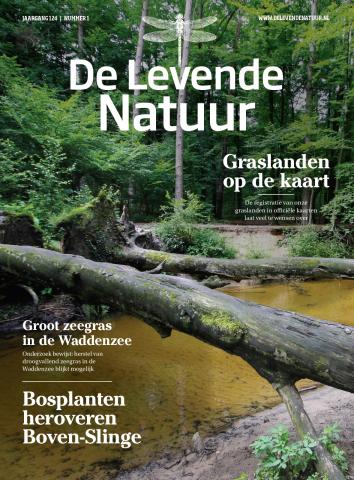De Levende Natuur nummer 1 van 2023 (English summary)
Afbeelding

Fast colonisation of forest plants along a Dutch lowland stream
John Lenssen & Jan Jansen
Stream dispersal may enhance colonisation by forest plant species, including the group of ancient forest species which have a high conservation value. To elucidate whether this applies to all forest species or a subset with particular traits, we monitored colonisation in two former agricultural fields during six consecutive years. Both fields were regularly flooded by a seminatural lowland stream in the eastern part of the Netherlands. Colonisation was positively related to upstream abundance and negatively to seed weight. Abundant species had a higher colonisation, provided their seeds were not too heavy. No colonisation was found if seeds were heavier than 10 mg.
Since about the vast majority of Dutch ancient forest species has lighter seeds than 10 mg, regular flooding may facilitate fast colonisation of old fields, provided the upstream population is sufficiently large. Hence, development of species-rich forests should be targeted on sites with upstream-connected established forests.
40 years of counting beetles and spiders shows diversity loss in the Lauwersmeer
Aat Barendregt & Tjesse Riemersma
From 1969 untill 2008, Jan Meijer measured changes in ground dwelling fauna in the Lauwersmeer, a reclaimed tidal estuary of the Waddensea. The area experienced a succession from open soil to a dense reed marsh. We show what this means for ground dwelling fauna and compare the results with the succession theory, which proves to develop differently for these species. Shortly after the installment of the dike, there is already a wide variety of species, which remains. The total biomass reaches its maximum after 5-15 years and lowers afterwards. Ultimately not only the fauna species change but the whole ecosystem turns towards a humid forest, with less characteristic biodiversity, comparable with many other locations. Reintroduction of dynamics would restore the ecosystem, but this has been in discussion for over 20 years, due to the fixed functioning of the lake for water management and agriculture.
Shoot! Disarming Japanese knotweed
Janneke van der Loop, Laura van Veenhuisen, Hein van Kleef, Anne Sluiter, Martijn van de Loo, Femke Soontiëns & Jan Reinders
Japanese knotweed is an invasive alien species, causing ecological and economic problems. These plants are difficult to eradicate, mainly because of their ability to reproduce vegetatively. Japanese knotweed has the ability to regenerate for a long time after fragmentation. To stop spreading by plant fragments, it is crucial that all plant material is disposed of and eradicated correctly. This experiment tests if covering root fragments with sand combined with inundation causes a loss of regenerative capacity. Inundation has proven useful in killing Japanese knotweed root fragments harvested in summer. Within three months all the submerged plant material lost its regenerative ability. In winter, the roots are more resilient to inundation; after three months there was no visible effect of the inundation. This difference could be caused by the season-based nutrient and energy differences in the plant roots.
Hopeful future for seagrass recovery in Wadden Sea
Max Gräfnings, Laura Govers, Jannes Heusinkveld, Maarten Zwarts, Dieuwke Hoeijmakers, Henk Wiersema, Gabriela Maldonado, Nadia Hijner, Clazina Kwakernaak, Yasmine Gatt, Thije Zuidewind, Ise Grimm, India Findji, Quirin Smeele, Tjisse van der Heide & Addo van der Eijk
In 2020, the largest intertidal population of eelgrass in the Dutch Wadden Sea could be found on a tidal flat – ‘de Grienderwaard’ – northeast of the uninhabited island of Griend. This population covered around 650 hectares. This field is the result of many years of research on eelgrass restoration strategies. The most recent project (2018 – 2022) has shown that intertidal eelgrass restoration in the intertidal Wadden Sea is possible. One of the key-factors behind this success is the improved seeding method. For this ‘Seeding Injection Method’ (DIS), seeds are injected 2-4 cm into the sediment with caulking guns. Prior to seeding, seeds were collected in German donor populations, stored during the winter under climate-controlled conditions and were copper treated. In this study, the DIS method was optimized, enabling precision-seeding, resulting in high plant densities (>50 plants m-2) and a reduction of seed losses (>99% to <86%). In addition, the method was also successfully tried on a large-scale (1 ha, 250 people hours of planting). The major achievement of this project was the successful establishment of the aforementioned population (>250 ha) as a result of in situ seed production in the field. The size, viability and expansion of this population indicates that restoration efforts highly likely resulted in the first sustainably restored intertidal eelgrass population in the Wadden Sea.

